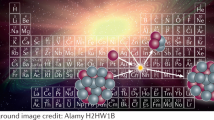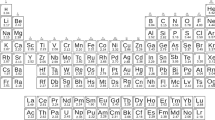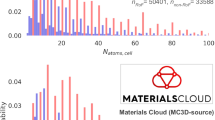Abstract
ALMOST five years ago, in a lecture to the Institute of Chemistry in London, the success that radioactive methods had achieved in the task of completing the Periodic System was described1. In the table given, the place of element 87 was filled by the symbol of a newly discovered branch product in the actinium series ; but in the places of elements 43, 61, 85 and 93 no symbols were inserted, although, as explained in some detail, atoms of all these four elements had been artificially produced.
This is a preview of subscription content, access via your institution
Access options
Subscribe to this journal
Receive 51 print issues and online access
$199.00 per year
only $3.90 per issue
Buy this article
- Purchase on Springer Link
- Instant access to full article PDF
Prices may be subject to local taxes which are calculated during checkout
Similar content being viewed by others
References
Nature, 149, 565 (1942).
Similar mistakes have been perpetuated in the older nomenclature. For example, the last of the rare earths should not be called lutetium (Lu), but cassiopelum (Cp); about the priority of Auer v. Welsbach's claim see F. A. Paneth, Ergeb. exak. Naturwiss., 2, 168 (1923).
Perrier, C., and Segrè, E., Rend. Lincei, 25, 723 (1937); J. Chem. Phys., 5, 712 (1937).
Seaborg, G. T., and Segrè, E., Phys. Rev., 55, 808 (1939); Segrè, E., Nature, 143, 460 (1939). See also Segrè, E., and Wu, C. S., Phys. Rev., 57, 552 (1940).
Pool, M. L., and Quill, L. L., Phys. Rev., 53, 437 (1938); Law, H. B., Pool, M. L., Kurbatov, J. D., and Quill, L. L., Phys. Rev., 59, 936 (1941); Kurbatov, J. D., MacDonald, D. C., Pool, M. L., and Quill, L. L., Phys. Rev., 61, 106 (1942).
Wu, C. S., and Segrè, E., Phys. Rev., 61, 203 (1942).
Corson, D. R., Mackenzie, K. R., and Segrè, E., Phys. Rev., 58, 672 (1940).
Karlik, B., and Bernert, T., Z. Phys., 123, 51 (1944).
Karlik, B., and Bernert, T., Naturwiss., 30, 685 (1942); Sitz. Wien. Acad., 151, 255 (1942).
Perey, M., J. Phys. et le Radium, 10, 435 (1939).
See especially G. T. Seaborg, Chem. and Engin. News Edit., 24, 1192 (1946).
McMillan, E. M., and Abelson, P. H., Phys. Rev., 57, 1185 (1940).
Kennedy, J. W., Seaborg, G. T., Segrè, E., and Wahl, A. C., Phys. Rev., 70, 555 (1946).
Seaborg, G. T., McMillan, E. M., Wahl, A. C., and Kennedy, J. W., Phys. Rev., 69, 366 (1946).
Bohr, N., "Spektren und Atombau" (Vieweg, 1922), 133.
Shapley, H., in "One World or None" (McGraw-Hill Book Co., 1946), 10.
Author information
Authors and Affiliations
Rights and permissions
About this article
Cite this article
PANETH, F. THE MAKING OF THE MISSING CHEMICAL ELEMENTS*. Nature 159, 8–10 (1947). https://doi.org/10.1038/159008a0
Issue Date:
DOI: https://doi.org/10.1038/159008a0
This article is cited by
-
Name game: the naming history of the chemical elements—part 3—rivalry of scientists in the twentieth and twenty-first centuries
Foundations of Chemistry (2023)
-
The need for a fresh symbol to designate copernicium
Nature (2009)
-
Naming elements after scientists: an account of a controversy
Foundations of Chemistry (2008)
-
Technetium, the missing element
European Journal of Nuclear Medicine (1996)
-
Die Geschichte der Entdeckung k�nstlicher Elemente
Die Naturwissenschaften (1964)
Comments
By submitting a comment you agree to abide by our Terms and Community Guidelines. If you find something abusive or that does not comply with our terms or guidelines please flag it as inappropriate.



